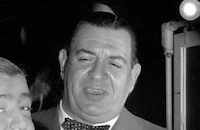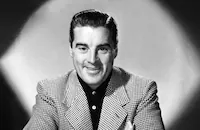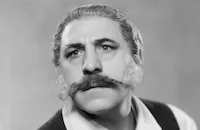Manhattan Merry-Go-Round
Cast & Crew
Charles F. Riesner
Phil Regan
Leo Carrillo
Ann Dvorak
Tamara Geva
James Gleason
Film Details
Technical Specs

Synopsis
Italian mobster Tony Gordoni buys the Associated Recording Company and acquires recording contracts with Ted Lewis, Kay Thompson and Cab Calloway. When his mother accuses him of being ashamed of his Italian heritage, Gordoni forces singer Jerry Hart to charm the hot-tempered opera star Charlizzini into making a record. Jerry, however, has just proposed to Associated secretary Ann Rogers, who had convinced Gordoni to record Jerry after he lost his job at the Manhattan Merry-Go-Round nightclub, and balks at the idea. Gordoni threatens to harm Ann if Jerry does not meet Charlizzini that evening, the night of Ann and Jerry's wedding. While Ann waits at the church, Jerry, along with Gordoni's thug, Danny the Duck, sings for Charlizzini and convinces her an album would make her a benefactor to shut-ins around the world. The next few days, Charlizzini monopolizes Jerry's time, insisting he call her "Charlie," and he is unable to explain to Ann. After opera impresario Martinetti refuses to allow Charlizinni to record, Gordoni takes her to a Long Island estate with Jerry to make it look as though she has been kidnapped. He then promises Martinetti he will return her if he allows her to record, and Martinetti acquiesces. Meanwhile, the police go to the estate and Charlizinni admits the abduction was a hoax to control Martinetti. Back at the studio, Ann refuses to speak to Jerry, and when Charlizzini throws a tantrum, Jerry scoffs at her and disappears. Danny locates Jerry on Gene Autry's ranch, singing with the Cowboy Band. By convincing Autry's group to record at Associated, Gordoni gets Jerry back to the studio. Meanwhile, Charlizzini and Gordoni fall in love and explain all to Ann. After Ann records a reconciliation speech, which they play for Jerry, the reunited couple embraces.

Director

Charles F. Riesner
Cast

Phil Regan

Leo Carrillo

Ann Dvorak

Tamara Geva

James Gleason
Ted Lewis

Cab Calloway

Kay Thompson
Joe Di Maggio

Henry Armetta
Luis Alberni
Max Terhune

Smiley Burnette
Louis Prima And His Band

Gene Autry
Selmer Jackson

Eddie Kane

Moroni Olsen
Nellie V. Nichols
Gennaro Curci
Sam Finn
Al Herman
Robert E. Perry
Jack Adair
Jack Jenny And His Orchestra
The Lathrops
Rosalean And Seville
Thelma Wunder
Ralph Edwards
Crew
John H. Auer
Gene Autry
Richard Byron
Sammy Cahn
Saul Chaplin
Albert Columbo
Eloise
Willard H. George
Harry Grey
Harry Grey
Jerome Jerome
Walter Kent
Muriel King
Jack Lawrence
John Victor Mackay
Jack Marta
Mauboussin, Trabert & Hoeffer, Inc.
Ernest Nims
Jack M. Owens
Harry Sauber
Harry Sauber
Murray Seldeen
George Sherman
Peter Tinturin

Film Details
Technical Specs

Award Nominations
Best Art Direction
Quotes
Trivia
It was while appearing as a guest star in this film that Joe DiMaggio first met his future wife, actress-dancer Dorothy Arnold, who was also appearing in it as a member of the chorus.
Archive newsreel footage of Joe DiMaggio's home run in the 1936 World Series is shown in the film.
Notes
In the opening credits, Gene Autry's photograph appears over the words "and introducing that cowboy singing star Gene Autry," however Autry had appeared in a number of films previous to this. The title Metropolitan Merry-Go-Round was announced in the 1935 Film Daily Product Guide as part of Republic's upcoming 1935-36 season, and contemporary news items from June and November 1935 list Pinky Tomlin and Roger Pryor in the cast. Production on Manhattan Merry-Go-Round did not start until early August 1937, however, and it is unclear whether Metropolitan Merry-Go-Round was an early title for this film. According to a news item in Hollywood Reporter on August 4, 1937, the day shooting began at Biograph Studios in New York, John Auer was set to direct ten days of shooting there. While a Hollywood Reporter production chart from day seven lists Auer as the New York director (with credited director Charles F. Reisner listed as director of the entire production), Auer is not credited on the screen or in reviews. The production note also lists Harry Grey as the film's New York producer (with credited producer Harry Sauber listed as the film's general producer), but Grey receives screen credit as the supervisor of all musical sequences. On September 22, 1937, Phil Regan returned to Republic for two days of added scenes. According to a September 1937 letter to AMPAS, the film's official billing below the title was changed from "with James Gleason-Tamara Geva" to "with Tamara Geva-James Gleason." The film contains newsreel footage of the homerun that Joe DiMaggio hit for the New York Yankees in the 1936 World Series. Although some sources include the Cab Calloway/Irving Mills song "Minnie the Moocher" in the credits, only the last few bars of the song were included in the film. In a nightclub sequence, Calloway ends the song, then tells the audience that they have just heard about Minnie the Moocher, and will now hear about a man named "Jasha." He and his orchestra then perform the song "Mama, I Want to Make Rhythm." According to a 1937 Hollywood Reporter announcement, Virginia Dabney was cast in this film, although her appearance in the final film has not been confirmed.

Miscellaneous Notes
Released in United States 1937
Released in United States 1937











